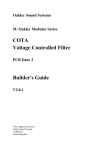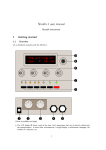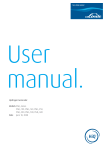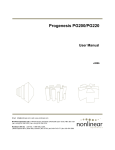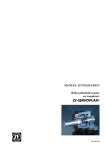Download Roland MKS-30 Specifications
Transcript
JX-3P MIDI Expansion Kit Owners manual and installation instructions Language: English Manual Version: 2.01 Date: 5 june 2010 Website: http://organix.inque.org Email: [email protected] * Roland is a registered trademark of Roland Corp. US JX-3P MIDI Expansion Kit Introduction Thank you for choosing the JX-3P MIDI Expansion Kit from Inque. The JX-3P MIDI Expansion kit adds more MIDI functionality to the JX-3P Synthesizer. When you do not have a PG-200 programmer, you can: Control the JX-3P realtime with standard MIDI-Control messages. These messages can be sent from a sequencer or a “MIDI-knobbox”. Load new patches in the JX-3P using a MIDI-file containing MIDIControl messages. Set the MIDI receive channel to 1, 2, 3 or OMNI. velocity sensitivity (MIDI input only, not the keyboard) When you have a PG-200 programmer, you can also: Use the MIDI input and PG-200 simultaneously. Use the PG-200 programmer to send out MIDI-Control messages and record it with a sequencer, or to control another MIDI device. The ROM firmware that comes with the kit is based on the original firmware. Therefore the well-beloved authentic sound of your JX-3P will be still the same after installation and the JX-3P still has all the original functionalities. The user memory patches will be retained after installation.* * Unless you short the backup battery or RAM IC during installation. Page 2 JX-3P MIDI Expansion Kit Precautions Please read the manual carefully before installing the kit! Caution The installation of the kit requires opening the JX-3P synthesizer case. Some knowledge about electronics and soldering is required. If you don’t have this knowledge and skills, please let a competent person do the installation for you. There are high and dangerous voltages inside the JX-3P, please follow the general safety precautions. Look out with static electricity. Static electricity could damage the kit and the JX-3P! Inque is not responsible for, but not limited to, personal injury, injury of other people, damage or loss of data caused by the use of the JX-3P MIDI Expansion kit! Inque is not associated to Roland Corp. US Installing and using the kit means that you accept and understand all of these terms. Page 3 JX-3P MIDI Expansion Kit Chapter 1. Opening the bag The DIY version contains: All electronic parts, pre-programmed microcontroller, double-sided PCB and a enclosure to build the mergerbox. Pre-programmed firmware ROM that must be installed in the JX-3P. 10-pins cable with connector. The pre-build version contains: A pre-build mergerbox. Pre-programmed firmware ROM that must be installed in the JX-3P. 10-pins cable with connector. Page 4 JX-3P MIDI Expansion Kit Chapter 2. Assembling the DIY version This chapter only applies to the DIY version. If you have the prebuild version, you should proceed with chapter 3. If you have the DIY version then the PCB of the mergerbox needs to be assembled by you. Assembling the PCB requires suitable soldering equipment and tools. The holes and pads on the mergerboard PCB are much smaller than those used on the DIN Board in the JX-3P. If you do not have experience with assembling PCBs, please let a competent person do the assembling for you. Damaged PCB and parts due to incorrect handling cannot be returned or exchanged. Always mount the smallest parts first. Do not use too much solder. Never use aggressive solder liquids like S-39. Consider the following PCB layout: Page 5 JX-3P MIDI Expansion Kit Please follow the following steps: Mount the resistors: R1 and R4: 220 Ohm. (Red – Red – Black – Black) R2 and R3: 1K. (Brown – Black – Black – Brown) Mount the IC socket (U1). Pay attention to which direction the socket must mounted. If you mount it the wrong way, it can be confusing how the IC must be inserted, resulting inserting the wrong way and a damaged IC. Mount the LED (D1). Pay attention to which way the anode ‘A’ / cathode ‘K’ is pointing. The longest leg on the led is the anode. If you mount it the wrong way, the LED will not work. Mount the two ceramic capacitors 22 pF (22J) on location C1 and C2. Mount the capacitor 100 nF (104R) on location C4. Mount the crystal 16 MHz on X1. Put the small plastic isolator between the crystal and the PCB. Mount the connector P1. Pay attention to how it must be mounted. Refer to the wire that must be connected to this connector. The Page 6 JX-3P MIDI Expansion Kit black wire must correspond to ‘A’, the brown wire to ‘B’… and the white wire to ‘J’. Mount the electrolytic capacitor 10 uF on location C3. Pay attention to the polarity!!! If you mount it the wrong way, it can explode. Insert the IC ‘Atmega8’ into socket U1. Pay attention to which direction it must be inserted. You could use some special PCB Cleaner spray to clean the PCB from solder flux, and give it a clean look. Double check your soldering contacts for accidentally unwanted shorts. There are six screws provided: two short screws, and four longer screws. Use the four longer to mount the PCB inside the box. Use to other two short screws to close the box. You are finished with the assembling. Proceed with chapter 3. Page 7 JX-3P MIDI Expansion Kit Chapter 3. Installation in the JX-3P This chapter applies to both the DIY and pre-build version and describes the following actions: Opening the case of the JX-3P Synthesizer. Installation of the new firmware ROM. Modification of the DIN board. Installation of the mergerbox. The following things are needed for the installation: The firmware ROM. The mergerbox The 10-pins cable with connector. Also needed (not included with the kit): A soldering iron. Sharp object such as a knife, for removing some PCB connections on the DIN board. Other general tools such as screwdrivers and pliers. An Ohmmeter, to inspect the removed PCB connections for unseen and unwanted shorts. Installation steps: Step 1. Disconnect the power plug!! Step 2. Place the JX-3P on a soft background to be sure that the front panel will not get scratched when the synthesizer is lying upside down. Page 8 JX-3P MIDI Expansion Kit Step 3. Turn the JX-3P upside down and remove the screws which are drawn in the picture below. Step 4. Turn the JX-3P upside back. Be careful, since the keyboard will be lose and could fall out. Remove the screws on the sides (a total of four screws). After this the front panel will be open. Page 9 JX-3P MIDI Expansion Kit Step 5. Rotate the front panel to the rear side. Make sure that there will be no cable damages. Remove the keyboard. You do not have to unplug the cables coming from the keyboard. From this step there are three actions that should be completed: Change the firmware ROM. Modify the DIN board and attach some cables to it. Install the mergerbox Page 10 JX-3P MIDI Expansion Kit Step 6. You can find the firmware ROM at the lower left side of the mainboard (IC52). The type will be 2764 or 2365 (sometimes with a label on it). If the firmware ROM is soldered on the mainboard, you need to desolder it and solder a IC-socked at the location. This action is not described further in this document. Carefully remove the old firmware ROM. Because the new firmware ROM has an larger chip capacity, an extra (address) line must be added from the CPU to the ROM. This must be done with pin 26 on both IC’s. Lift up pin 26 from each IC to make it ‘bend over’ the socket. Make sure that the bended pin 26 is not making contact again with the socket or with the metal frame of the keyboard when you put the IC back into the socket. Solder a wire on both pins so both IC’s are connected to each other. Make sure you do not keep the wire too long since it may pick up unwanted interference. In some cases the CPU is soldered into the circuitboard. Luckily, it’s not needed to solder out the CPU or pin since pin 26 is not connected on the circuitboard. Just solder the wire directly to pin 26 of the CPU on the circuit board. If the CPU is socketed, take out the CPU from the socket and bend over pin 26. Page 11 JX-3P MIDI Expansion Kit Place the new firmware ROM in the socked. Take attention of the direction of pin 1! Wrong inserting of the IC could be damage the IC and other components in the JX-3P! Keep the original firmware ROM in a safe place. Step 7. Remove the DIN board from the upper side of the front panel. Remember the location of the three connected cables (CN1 JACK, CN2 POWER and CN3 MAIN). Tip: you could write the numbers on the connectors with a water-resistant marker. Page 12 JX-3P MIDI Expansion Kit Step 8. This step describes how to modify the DIN-board. There are two versions: one with MIDI-Thru and one without MIDI-Thru. Both PCB layouts are given on the following pages. The modifications on both boards are the same, only the locations are different. Cut the PCB connection at point 1 and 2. Scrap off a small portion of the coating using a screwdriver or a knife, until you see some copper. Use an Ohmmeter to make sure that to PCB connection is really cut in two. Remove resistor R4 at point 3. Remove also the connection (a wire bridge) W6 at point 4. Solder the wires of the 10-pins cable on the PCB at the given locations in the following PCB layouts. (wires A to J). Some points require soldering on the PCB wires. Scrap off a small portion of the coating when needed. Page 13 JX-3P MIDI Expansion Kit DIN-Board without MIDI-Thru output Page 14 JX-3P MIDI Expansion Kit DIN-Board with MIDI-Thru output Page 15 JX-3P MIDI Expansion Kit Step 9. Verify that all the connections are done correctly. You can bind the wires together with tape. Place the DIN-board back into the front panel and attach the three connectors to it. Connect the 10-pins cable connector to the small plastic box. Mount the plastic box with double sided tape on the backside of the front panel, next to the DIN-board. Take attention that the electronics box will not collide with the power supply when the case is closed. Close the case and put all screws back in place. That’s it! You are finished with the installation! Page 16 JX-3P MIDI Expansion Kit Chapter 4. MIDI Channel select After installation the memory protect function will be always off. The function of the PG200 / MIDI switch on the backside will be changed after installation of the kit. The switch will function as a MIDI channel selector. Switch position PG200 MIDI channel 1 PG200 protect MIDI 2 3 The JX-3P selects the (new) MIDI channel after power up. Varying the setting of the switch while powered up does not change the MIDI channel. You need to power off and on the JX-3P again after choosing a different MIDI channel. After power up the JX-3P, OMNI modus will be off. You can set the JX-3P into OMNI modus by sending a MIDI controller 125 message to the JX-3P. After that the JX-3P will listen to all MIDI channels. OMNI modus can be turned off by sending a MIDI controller 124 message to the JX-3P. Chapter 5. Velocity sensitive mode To get into the velocity sensitive mode, hold down ‘7’ while power up the JX-3P. The keyboard and sequencer will be disabled in this mode. The JX3P will now receive MIDI velocity values. Page 17 JX-3P MIDI Expansion Kit Chapter 6. Troubleshooting and FAQ Q: How do I know that the JX-3P will work in my JX-3P version? A: Generally, there are two versions of the JX-3P: The non-MIDI-Thru and the MIDI-Thru version. Both versions are supported by the JX-3P MIDI expansion kit. The kit has been installed in a variety of JX-3P's in the past, in all cases without problems. Q: Is it possible to install this kit in a MKS-30 - since it is the rackmount module of the JX-3P? A: No, the kit can be only installed in a JX-3P. There is a MIDI upgrade for the MKS-30 available at http://analog.no Q: After installing the JX-3P MIDI Expansion kit, it is possible to use Sysex to control the JX-3P? A: No, the JX-3P MIDI Expansion kit uses standard MIDI CC messages rather than Sysex. Realtime control with CC is MUCH easier to use for realtime control, and CC is most of the time better implemented in MIDI Knobboxes and sequencers than Sysex. Q: Unfortunately I do not have the PG200 programmer. Is it possible to only install the EPROM with new firmware, instead of installing both the EPROM and Mergerbox? A: All of the features of the JX-3P MIDI Expansion kit are implemented in the mergerbox. Just installing the EPROM will not work, they must both be installed. Q: I have a non-working JX-3P, will this kit bring new life in it? A: No, the kit will not 'resurrect' a non-working JX-3P. It must be installed in a working-condition JX-3P. Page 18 JX-3P MIDI Expansion Kit Q: Why is the LFO Delay not working when I play a note through MIDI? A: This is a classic bug from Roland in the original JX-3P firmware. There is nothing I can do about it, I'm afraid. Fortunately the bug was fixed in the velocity mode. But in the normal mode, it is still there... Q: I know that the resolution of the parameters on the PG200 are 8-bit. Since MIDI has only 7-bit, will the resolution of my PG200 also be reduced after installation of the JX-3P MIDI Expansion kit? A: No, the PG200 still sends 8-bit resolution to the JX-3P. Only the PG200 to MIDI and MIDI to JX-3P signals are 7-bit. Q: Help!! I have installed the kit and my JX-3P randomly hangs and after that the LED's are flickering and there is no sound. A: This is caused due to an incorrectly installed firmware ROM (or a bad ROM, but this occurs less often). Check if you have bended PIN 26 too far, resulting in a electrical contact with the metal frame of the keyboard. It is also possible that PIN 26 is bended not far enough, resulting in a contact with GND of the socket. It is also possible that the wire between the EPROM and the CPU is not making a clean contact or causing a short with some other pin. All such situations will cause problems, and random behaviors. Q: My JUNO-106, MKS-30 and GR-700 have had voice-problems due to a faulty 80017A VCF/VCA module (a.k.a. 'Voicechip'). Should I expect the same troubles with the JX-3P? A: Fortunately the JX-3P does NOT contain this notorious 80017A module. The JX-3P uses the IR3109 instead of the 80017A. This is the same filter chip as found in the JUNO-6/60 and Jupiter synthesizers. Unlike the 80017A, there are no known problems for this chip. Page 19 JX-3P MIDI Expansion Kit Chapter 7. MIDI Specifications MESSAGE TYPES Note event Note off Status 8nH 9nH kkH: vvH: Second kkH kkH Third vvH 00H Note number 24H – 60H (36 – 96) C2 – C7 Don’t care Note on Status 9nH kkH: vvH: Second kkH Third vvH Note number 24H – 60H (36 – 96) C2 – C7 Velocity 1H – 7FH (1 – 127). (Only in velocity mode.) Continuous Controller Hold 1 Status BnH vvH: Second 40H Third vvH Hold Pedal Off 0H – 3FH (0 – 63) Hold Pedal On 40H – 7FH (64 – 127) Synthesizer parameter Status BnH Second ppH Third vvH ppH: Parameter controller number * vvH: Value 0H – 7FH (0 – 127) * see “Parameter address table” for detailed information. Program change Status CnH Second ppH ppH: Program number 0H – 40H (0 – 64) Pitch bender Status EnH mmH: nnH: Second mmH Third nnH 0H – 7FH (0 – 127) Least significant byte 0H – 7FH (0 – 127) Most significant byte Page 20 JX-3P MIDI Expansion Kit PARAMETER ADDRESS TABLE Parameters CC number Description Value – Dec (Hex) 12 (0CH) Fine Tune 0 – 127 (00H – 7FH) 13 (0DH) Tune 0 – 127 (00H – 7FH) 14 (0EH) DCO Envelope Mod. 0 – 127 (00H – 7FH) 15 (0FH) DCO LFO Mod. 0 – 127 (00H – 7FH) 16 (10H) Source Mix 0 – 127 (00H – 7FH) 17 (11H) High Pass 0 – 127 (00H – 7FH) 18 (12H) Resonance 0 – 127 (00H – 7FH) 19 (13H) Cutoff Frequency 0 – 127 (00H – 7FH) 20 (14H) VCF Envelope Mod. 0 – 127 (00H – 7FH) 21 (15H) VCF LFO Mod. 0 – 127 (00H – 7FH) 22 (16H) Pitch Follow 0 – 127 (00H – 7FH) 23 (17H) VCA Level 0 – 127 (00H – 7FH) 24 (18H) LFO Rate 0 – 127 (00H – 7FH) 25 (19H) LFO Delay 0 – 127 (00H – 7FH) 26 (1AH) Attack 0 – 127 (00H – 7FH) 27 (1BH) Decay 0 – 127 (00H – 7FH) 28 (1CH) Sustain 0 – 127 (00H – 7FH) 29 (1DH) Release 0 – 127 (00H – 7FH) CC number Description Value – Dec (Hex) 72 (48H) DCO-1 Range 0 (00H) 16’, 32 (20H) 8’, 64 (40H) 4’ 73 (49H) DCO-1 Wave 0 (00H) ramp, 32 (20H) pulse, 64 (40H) square 74 (4AH) DCO-2 Range 0 (00H) 16’, 32 (20H) 8’, 64 (40H) 4’ 75 (4BH) DCO-2 Wave 0 (00H) ramp, 32 (20H) pulse, 64 (40H) square, 96 (60H) noise 76 (4CH) DCO-2 Cross Mod. 0 (00H) off, 32 (20H) sync, 64 (40H) metal 77 (4DH) VCF Envelope Polarity 0 (00H) inverted, 64 (40H) normal 78 (4EH) VCA Mode 0 (00H) gate, 64 (40H) envelope 79 (4FH) DCO-2 Envelope Mod. 0 (00H) off, 64 (40H) on 80 (50H) DCO-2 LFO Mod. 0 (00H) off, 64 (40H) on 81 (51H) DCO-1 Envelope Mod. 0 (00H) off, 64 (40H) on 82 (52H) DCO-1 LFO Mod. 0 (00H) off, 64 (40H) on 83 (53H) LFO Wave 0 (00H) triangle, 32 (20H) square, 64 (40H) random, 96 (60H) fast random 84 (54H) DCO Envelope Polarity 0 (00H) inverted, 64 (40H) normal 85 (55H) Chorus 0 (00H) chorus off, 64 (40H) chorus on Switches Page 21 JX-3P MIDI Expansion Kit MIDI IMPLEMENTATION CHART Function Transmitted Received Comments Basic Channel 1, 2, 3 1, 2, 3, OMNI User defined Note Number 36 – 96 36 – 96 C2 – C7. Received note numbers outside the range will be transposed. O O O O A preset velocity of 64 is transmitted. Velocity Note ON Note OFF Velocity values are only received in the velocity mode. Pitch Bend O O Control Change Parameters: 13, 14, 15, 16, 17, 18, 19, 20, 21, 22, 23, 24, 25, 26, 27 Parameters: 13, 14, 15, 16, 17, 18, 19, 20, 21, 22, 23, 24, 25, 26, 27 Hold: 64 Hold: 64 Switches: 72, 73, 74, 75, 76, 77, 78, 79, 80, 81, 82, 83, 84, 85 Switches: 72, 73, 74, 75, 76, 77, 78, 79, 80, 81, 82, 83, 84, 85 Program Change O O System Exclusive X X System Common X X System Real Time X X X X X O X X X X X O X X Aux Message All Sound Off Reset Controllers Local ON/OFF All Notes Off Active Sense Reset Page 22






















